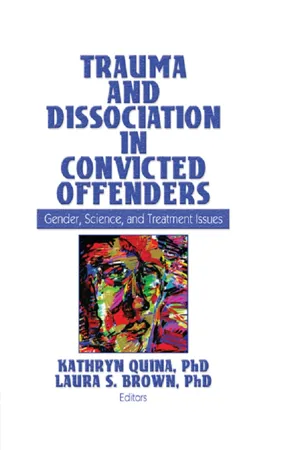
Trauma and Dissociation in Convicted Offenders
Gender, Science, and Treatment Issues
Kathryn Quina, Laura Brown, Kathryn Quina, Laura Brown
- 164 Seiten
- English
- ePUB (handyfreundlich)
- Über iOS und Android verfügbar
Trauma and Dissociation in Convicted Offenders
Gender, Science, and Treatment Issues
Kathryn Quina, Laura Brown, Kathryn Quina, Laura Brown
Über dieses Buch
Better understand the men and women most affected by trauma in our society Convicted offenders quite often are found to have a history of trauma. Trauma and Dissociation in Convicted Offenders: Gender, Science, and Treatment Issues provides a comprehensive look at the connection between complex trauma and the likelihood of being a convicted offender. This unique text focuses on what factors increase the likelihood of being a convicted offender, and what treatment possibilities lay ahead for these individuals. Substance abuse, childhood sexual abuse, and other traumatic experiences and their links to incarcerated men and women are discussed in detail. Interventions and research within the corrections system are examined, with recommendations on how to better serve this population. Trauma and Dissociation in Convicted Offenders: Gender, Science, and Treatment Issues takes a reasoned stand on women and men in prison, understanding that while they are being punished for breaking the law, they also are survivors of trauma whose dysfunctions underscore the need for greater understanding and more research. This valuable source presents the most current research results while providing a clear view on important future directions of study and focus. Each chapter of this insightful resource is extensively referenced and many have tables to clearly present data. Topics in Trauma and Dissociation in Convicted Offenders: Gender, Science, and Treatment Issues include:
- the relationship between post-traumatic stress and lifetime substance abuse among incarcerated women
- research on women inmates with HIV sexual risk and hazardous drinking behavior
- study on the link between trauma and women domestic violence offenders
- dissociation and memory in sex abusers
- the 're-criminalization' of mental illness
- the effectiveness of group therapy for incarcerated women survivors of childhood sexual abuse (CSA)
- challenges, ethical issues, and benefits of conducting research with abuse survivors in a women's prison facility
Trauma and Dissociation in Convicted Offenders: Gender, Science, and Treatment Issues is an essential resource for clinicians, educators, students, policymakers, and researchers.
Häufig gestellte Fragen
Information
Inhaltsverzeichnis
- Cover
- Halftitle
- Title
- Copyright
- Contents
- About the Editors
- Introduction
- The Relationship of Lifetime Polysubstance Dependence to Trauma Exposure, Symptomatology, and Psychosocial Functioning in Incarcerated Women with Comorbid PTSD and Substance Use Disorder
- Levels of Trauma Among Women Inmates with HIV Risk and Alcohol Use Disorders: Behavioral and Emotional Impacts
- Women Domestic Violence Offenders: Lessons of Violence and Survival
- Dissociation and Memory for Perpetration Among Convicted Sex Offenders
- Traumatized Offenders: Don’t Look Now, But Your Jail’s Also Your Mental Health Center
- Developing and Assessing Effectiveness of a Time-Limited Therapy Group for Incarcerated Women Survivors of Childhood Sexual Abuse
- Through the Bullet-Proof Glass: Conducting Research in Prison Settings
- Index